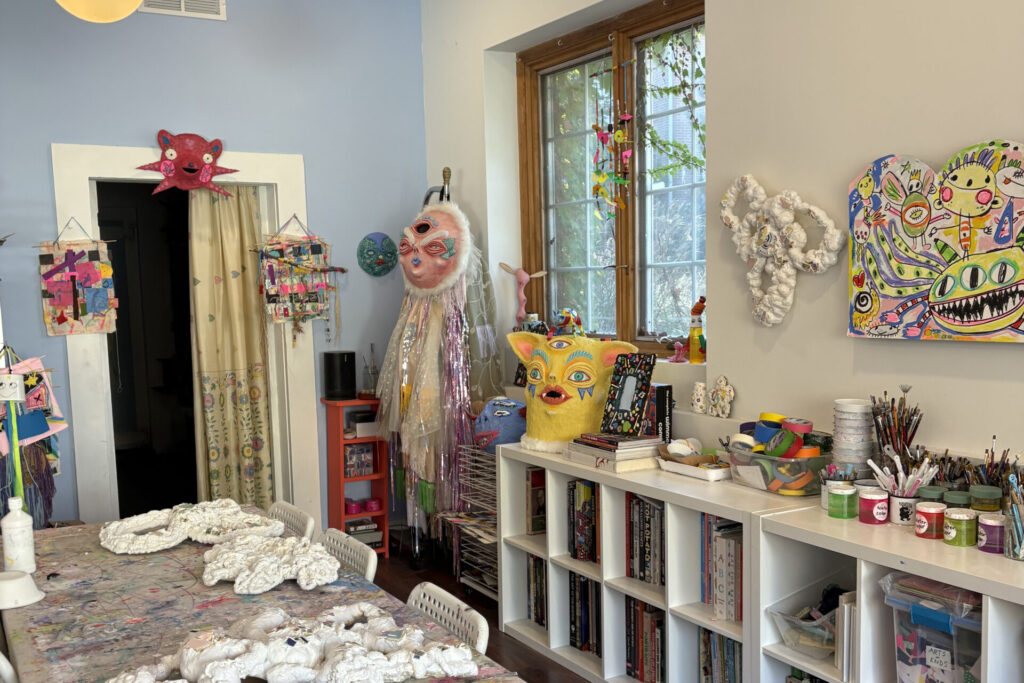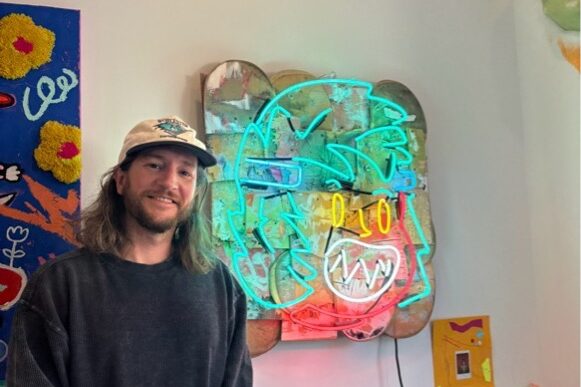Between Two Worlds: Ramiro Dávaro-Comas paints the immigrant experience
Local artist paints the immigrant experience
How one artist based in Albany turns his own immigrant experience into powerful visual art.

If you ever find yourself passing through Albany, New York, and continue south towards I-90 for 20 minutes, you’ll arrive in the quaint village of Kinderhook. Considered one of the oldest towns in the state, Kinderhook is a charming village that houses an array of restaurants, local shops, and even art spaces.
One of these spaces is Super-Stories, a non-profit art space co-founded in 2023 by artist, educator, and volunteer firefighter Ramiro Dávaro-Comas alongside his partner.
Walking inside Super-Stories, located just off Chatham Street beside the historic Van Buren Hall, the space vibrates with intense creative energy. Paint, recycled materials, and other artistic tools fill every corner. Surrounded on the walls hang some of the past and current works of Dávaro-Comas, and the scent of dried paint lingers in the air – an aroma that instantly transports you to those days in elementary art classes when artistic liberties seemed boundless.
“I work with so many young kids and the work that they make is so much better than work that I see in so many different places,” Dávaro-Comas said.
The space is surrounded by unfinished sculpture workings and colorful canvases, like the one close to the entrance of the space depicting two cartoon-like figures sitting close together on a skateboard, surrounded by a background mixed of blues and purples.
Yet, while Super-Stories represents his commitment to collective storytelling through public art, Dávaro-Comas’ own artistic practice is one of deep personal expression.
His ongoing series, Familias, currently being exhibited alongside artwork of students from Clinton Middle School at the Kirkland Art Center in Clinton, NY, explores themes of identity, migration, and belonging.
Dávaro-Comas, originally from Buenos Aires, first immigrated to the U.S in the early 90’s when he was around 5 years-old with his family. His own journey and experiences as a child heavily influenced this series.
“Where do I belong was something that I thought a lot about when I was younger,” Dávaro-Comas said. “Because in Argentina, I’m like the kid from the U.S, the kid that speaks English, you’re the American.”
“And then here I’m like the kid from Argentina, but you speak English really well, but still, what’s up with your parents?” Dávaro-Comas added.

Dávaro-Comas stated how as a young child moving to Central Massachusetts from Argentina, there was hardly ever an integration of cultures. He expressed how growing up, he only ever experienced Spanish in Argentina and English here in the states. He makes mention of actor and comedian John Leguizamo and musical act Calle Trece, whose integration of Spanish and English in their works was one of Dávaro-Comas’ earliest exposures to multiculturalism in art and media.
“When you’re a kid you just aren’t exposed to things like that,” Dávaro-Comas said. “So, I think that’s when I realized like you can bring both together and make this new fused culture.”
His exhibition of “Familias” first came into fruition back in 2017 and was completed a year ago. The series features multiple colorful canvases with cartoon-like characters (a trade-mark style of Dávaro-Comas) in what seem like happy and inviting spaces, though on closer inspection, the audience is able to further understand the artists’ intentions.
“The real point of why it’s so colorful, why it’s playful and cartoon-like, is so that it’s attractive to people,” Dávaro-Comas explained while gesturing into the air from behind his desk.
In his artist statement, he goes deeper into the symbolism behind his work, explaining how the characters depicted in his art all have gray skin because immigrants are labeled as ‘illegal aliens.’
“The most famous aliens that people always talk about are the gray aliens,” Dávaro-Comas said. “So, I wanted to give them that skin so they could visualize what people are saying when they use those words.”
Someone who believes in Dávaro-Comas’ artistic mission is Anita Welych, visual artist and Executive Director for the Kirkland Art Center since 2023. Anita expressed that featuring Dávaro-Comas’ work was crucial for opening dialogue about immigration – a conversation that has taken on new significance during a period of heightened political tension surrounding the issue.
“The lens of art gives us sort of a safe space for doing that, or at least a safer space,” Welych said. “People can talk about the art, but really, they’re talking about the issue, and they’re really interrogating themselves sometimes, like, how do I feel about this?”
Although the exhibition for “Familias” has come to an end, Dávaro-Comas’ work regarding immigration is far from over.
“The stuff that now I’m working on is different,” Dávaro-Comas said. “It’s more like portraiture and it’s all based off photos—somewhat semi-famous photos that have been in newspapers, or part of the Smithsonian Institute’s catalog of migrant families in the U.S.”
Dávaro-Comas work with “Familias” and future series offer a glimpse into the reality of millions who currently face issues of immigration. His art doesn’t just document the immigrant experience—it demands we witness it, feel it, and recognize ourselves within it.
